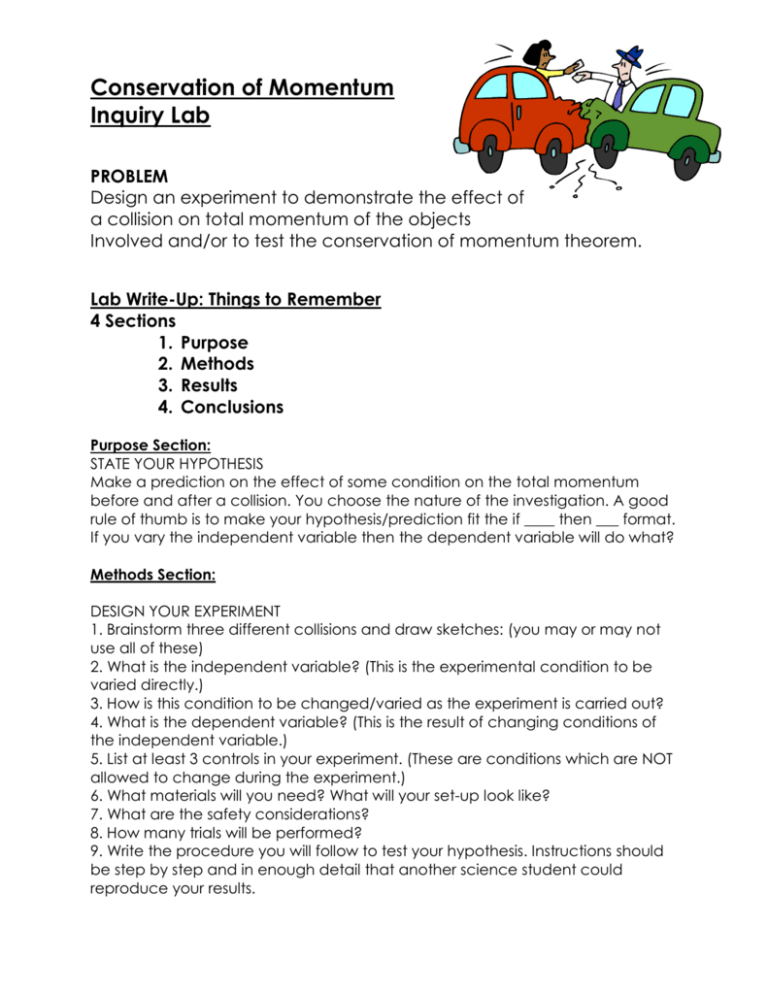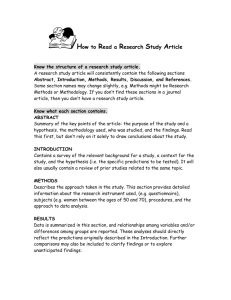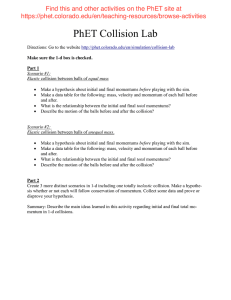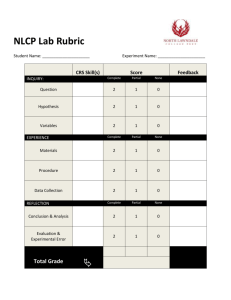Conservation of Momentum Lab: Experiment Design
advertisement

Conservation of Momentum Inquiry Lab PROBLEM Design an experiment to demonstrate the effect of a collision on total momentum of the objects Involved and/or to test the conservation of momentum theorem. Lab Write-Up: Things to Remember 4 Sections 1. Purpose 2. Methods 3. Results 4. Conclusions Purpose Section: STATE YOUR HYPOTHESIS Make a prediction on the effect of some condition on the total momentum before and after a collision. You choose the nature of the investigation. A good rule of thumb is to make your hypothesis/prediction fit the if ____ then ___ format. If you vary the independent variable then the dependent variable will do what? Methods Section: DESIGN YOUR EXPERIMENT 1. Brainstorm three different collisions and draw sketches: (you may or may not use all of these) 2. What is the independent variable? (This is the experimental condition to be varied directly.) 3. How is this condition to be changed/varied as the experiment is carried out? 4. What is the dependent variable? (This is the result of changing conditions of the independent variable.) 5. List at least 3 controls in your experiment. (These are conditions which are NOT allowed to change during the experiment.) 6. What materials will you need? What will your set-up look like? 7. What are the safety considerations? 8. How many trials will be performed? 9. Write the procedure you will follow to test your hypothesis. Instructions should be step by step and in enough detail that another science student could reproduce your results. PLAN FOR DATA COLLECTION & ANALYSIS 1. What data will you be collecting? 2. Have you sketched the expected before and after motion of the carts or objects? Plan to label units and directions of motion. Draw rough sketches. 3. Have you designed a data table? 4. How do you plan to analyze the data? Do you anticipate any results/patterns that may be best displayed in graphical form? Results Section: CONDUCTING THE EXPERIMENT Run the experiment you have designed. Did anything unusual happen? Were there any special insights you gained and want to make a note of? Were there any changes made to your procedure? What new questions arose? Conclusions Section: COMPARE 1. Were any of the results NOT what you expected? 2. Which of your pre-lab ideas have you decided are now incorrect? Why? 3. Did the data support your original hypothesis? 4. If not, what hypothesis does the data support? PERSUADE 1. What conclusion(s) did you reach due to the results of this experiment? 2. What evidence supports your conclusion(s)? 3. Are your results reliable? How did you compensate for sources of error in the experiment? 4. What predictions are you able to make, based on your conclusion(s)? 5. Can you test the predictions? If so, do results agree with your conclusion(s)? 6. What new problems/questions does the experiment bring up? 7. Are there any other investigations you could do? RELATE 1. What are some possible applications of your conclusions to the real world situations? 2. Do the results of your experiment fit any laws/theories of physics?











